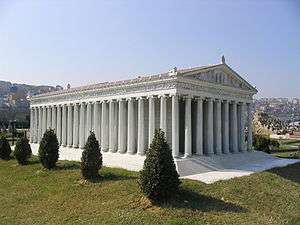Herostratus
| Herostratus | |
|---|---|
| Native name | Ηρόστρατος |
| Died | c. 356 BC |
| Cause of death | Execution |
| Known for | Destroying the Temple of Artemis at Ephesus |
Herostratus (Ancient Greek: Ἡρόστρατος) — or Erostratus — was a 4th-century BC Greek arsonist, who sought notoriety by destroying one of the Seven Wonders of the Ancient World. His acts then prompted the creation of a law forbidding anyone to mention his name. Nevertheless, his name has become a metonym for someone who commits a criminal act in order to become noted.
History

On a date said to be equivalent to 21 July 356 BC, seeking notoriety, Herostratus burned down the Temple of Artemis at Ephesus, in the Persian Empire (now Turkey). The temple honoured a local goddess, conflated by the Greeks with Artemis, their goddess of the hunt, the wild, and childbirth. The temple was constructed of largely of marble and was built by King Croesus of Lydia to replace an older site destroyed during a flood. Measuring 130 metres (430 feet) long and supported by columns 18 metres (59 feet) high, it was one of the Seven Wonders of the Ancient World.
Herostratus claimed credit for the arson in an attempt to immortalise his name. To dissuade those of similar intentions, the Ephesian authorities not only executed him, but attempted to condemn him to a legacy of obscurity by forbidding mention of his name under penalty of death. However, this did not succeed in wiping the name of Herostratus from history, because the event appears in Philippics of the ancient historian Theopompus[1] and later in the works of Strabo.[2] It is said that in fact his name has outlived the names of his judge, and in his Hydriotaphia Sir Thomas Browne said: But the iniquity of oblivion blindly scattereth her poppy, and deals with the memory of men without distinction to merit of perpetuity... Herostratus lives that burnt the Temple of Diana, he is almost lost that built it... Who knows whether the best of men be known? or whether there be not more remarkable persons forgot, than any that stand remembred in the known account of time?[3]
Legacy
Herostratus's name lived on in classical literature and has passed into modern languages as a term for someone who commits a criminal act in order to achieve notoriety, thus winning herostratic fame.
In language
The English term Herostratic fame relates to Herostratus and means "fame sought by criminal or otherwise disreputable means".
In media
- Chaucer makes reference to Herostratus[4] in The House of Fame: "I am that ylke shrewe, ywis, / That brende the temple of Ysidis / In Athenes, loo, that citee." / "And wherfor didest thou so?" quod she. / "By my thrift," quod he, "madame, / I wolde fayn han had a fame, / As other folk hadde in the toun..."[5]
- Many authors from sixteenth and seventeenth-century Spain refer to Herostratus to represent someone who will do anything to gain notoriety. He is discussed in Chapter 8 of the second part of Cervantes' Don Quixote (1615), along with Julius Caesar and Hernán Cortés among others. Don García, the protagonist of Ruiz de Alarcón's La verdad sospechosa (Suspect Truth), compares his feats to the ancient character.[6]
- In the chapter titled "Dreams" in Herman Melville's Mardi, and a Voyage Thither (1849), the protagonist states, "[W]hoso stones me, shall be as Erostratus, who put torch to the temple..." [7]
- Jaroslav Hašek in the preface of his last novel, The Good Soldier Švejk, compared Herostratus to Švejk (the protagonist) and praised the latter.
- The protagonist of the 1967 film Herostratus hires a marketing company to turn his suicide-by-jumping into a mass-media spectacle.
- Jean-Paul Sartre's short story Erostratus is directly based on the story of Herostratus.
References
- ↑ Albert Borowitz (January 2005). Terrorism for Self-glorification: The Herostratos Syndrome. Kent State University Press. pp. 6–. ISBN 978-0-87338-818-4.
- ↑ Strabo of Amaseia (13 February 2016). Delphi Complete Works of Strabo - Geography (Illustrated). Delphi Classics. pp. 4279–. ISBN 978-1-78656-368-2.
- ↑ The Works of Sir Thomas Browne Volume III p. 139. Pub: Edinburgh John Grant 1907 https://archive.org/details/cu31924064959640
- ↑ James Bowman (April 18, 2001). "From Heroes to Herostratus". JamesBowman.net. Retrieved September 19, 2011.
- ↑ Geoffrey Chaucer (1379–1380). "The House of Fame". The Works of Geoffrey Chaucer. Georgetown University. Retrieved September 19, 2011.
- ↑ Frederick A. de Armas, "The Burning at Ephesus: Cervantes and Alarcón's La verdad sospechosa," Studies in Honor of Gilbert Paolini, ed. Mercedes Vidal Tibits. Newark, Delaware: Juan de la Cuesta, 1996, pp. 41–55.
- ↑ Herman Melville. "Mardi, and a Voyage Thither". Retrieved February 12, 2014.
Bibliography
- HEROSTRATUS in Smith, William, ed. (1870) Dictionary of Greek and Roman Antiquities, V. 2, p. 439.